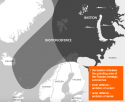No, you're missing the point.
Bastions are simply areas where you have air and maritime superiority, which means you can safely operate airplanes and ships in relative safety.
Your lack of studying naval history is showing. The Bastion strategy was devised by the Soviets.
Soviet and Russian Naval Bastions[]
The bastion became an important strategy for the ballistic missile submarine fleets of the
during the
. The
was made a bastion for the
, and the
for the
, both of which remain important to the
and the
.
The
had (and, even more so,
now has) limited access to the world's oceans: her northern coast is ice-bound at least the majority of the year, and access to the Atlantic requires transiting the
; much of her eastern coast is also ice-bound and requires moderately close approaches to either
or
; travel from her southern ports involves transiting first the
and
, and then either the
or the
.
The
originally attempted to directly contest with the navies of
for control of the
ocean. As the
progressed, however, it became clear that the Soviets could not win a toe-to-toe fight in the deep water, and the information sold to the Soviets by the
in the 1980s made it clear that the ballistic missile submarines, in particular, were very unlikely to be able to carry out their nuclear attack missions.
Realizing their vulnerability, the Soviets adopted a two-level approach. They armed their older, noisier, and less reliable "second generation" ballistic missile submarines with shorter-range nuclear weapons and deployed them as close as possible to the
.
, which suffered a catastrophic explosion and fire off
on 3 October 1986, was one such boat. Meanwhile, they used the information provided by Walker to build both dramatically improved attack boats such as the
, as well as more-survivable "boomers" such as the
armed with increasingly accurate and long-range missiles. Then they held those "third-generation" boats close to home, patrolling only near and under the Arctic ice cap. To secure the bastions, they also built large numbers of
and
, whose primary mission was anti-submarine barrier and picket patrol; furthermore, the Soviet carrier-building projects were dedicated to defense of these bastions as well rather than independent
, with
limited to anti-submarine
,
carrying
fighters as well as helicopters and a sizeable array of weapons (hence the designation
), and, finally,
fielding
.
The
practiced penetrating these bastions; one such attempt resulted in the
between
and
, a
. The collision was inadvertent and potentially catastrophic, but did demonstrate that US attack submarines were able to get rather near their intended prey.
Chinese Naval Bastions[]
There are indications that the Chinese
is adopting the concept as well, fortifying the
for use by its growing number of ballistic missile submarines.
United States Naval Bastions[]
In the sense that a bastion is set up to protect the naval forces themselves rather than a land feature (
e.g. the
), the
has never made significant use of the bastion concept.
Requirement
1. China needs to defend its coast because:
1a. There are densely populated cities all along the coastline
1b. It protects military facilities along the coast, and also in the interior.
1c. The Chinese interior is also densely populated
How this happens
2. Land-based SAMs (with a range of 400km) can effectively hide in the urban terrain of mainland China.
3. These land-based SAMs can work with AWACs aircraft overhead, which also have a radar horizon of 420km
4. Chinese fighter CAP will also be operating in this area.
5. It means enemy aircraft and ships will be at very high risk if they try to operate within 400km of the Chinese coast.
6. And the waters next to the Chinese coast benefit from being under this protective umbrella.
Oh. If the USN can strike off over 400km and hit the Chinese coastal cities and ports, what's the point of all that? Tomahawks have 1000km.
Stealth aircraft and the use of ECM reduces the protective bubble significantly because you cannot detect at the maximum range of your sensors. SAM missiles have the lowest probability of kill at their maximum range. The protective bubble becomes like a sponge then full of holes where things can get through.
And if South Korea declares war, Seoul accounts for half of the population.
But Seoul is only 400km from Shandong province and 350km from Dandong city.
This means Seoul is already within the A2AD bubble created by Chinese AWACs and SAMs.
They don't have to declare war. All it takes is US assets to attack from South Korea.
The Bohai Sea is a SECONDARY theatre.
Will the US have many spare assets, given that the critical action will be elsewhere?
Plus will South Korea and Japan actually declare war on China?
They might be obligated to.
Japan is 1000km from the Bohai Sea. They would have to cross South Korea and pass the Shandong peninsula to get to the Bohai Sea.
What are the odds of US airplanes and ships making it through?
That is more than enough for the US 7th Fleet to go the East China Sea and rain Tomahawks there.
You simply don't seem to have any idea what the other side is capable of, while continuing to propose static, outdated tactics. A Great Wall in the Sea will easily be overcome. 400km isn't enough of a buffer. In a Taiwan scenario, US fleets can stand off even further.

